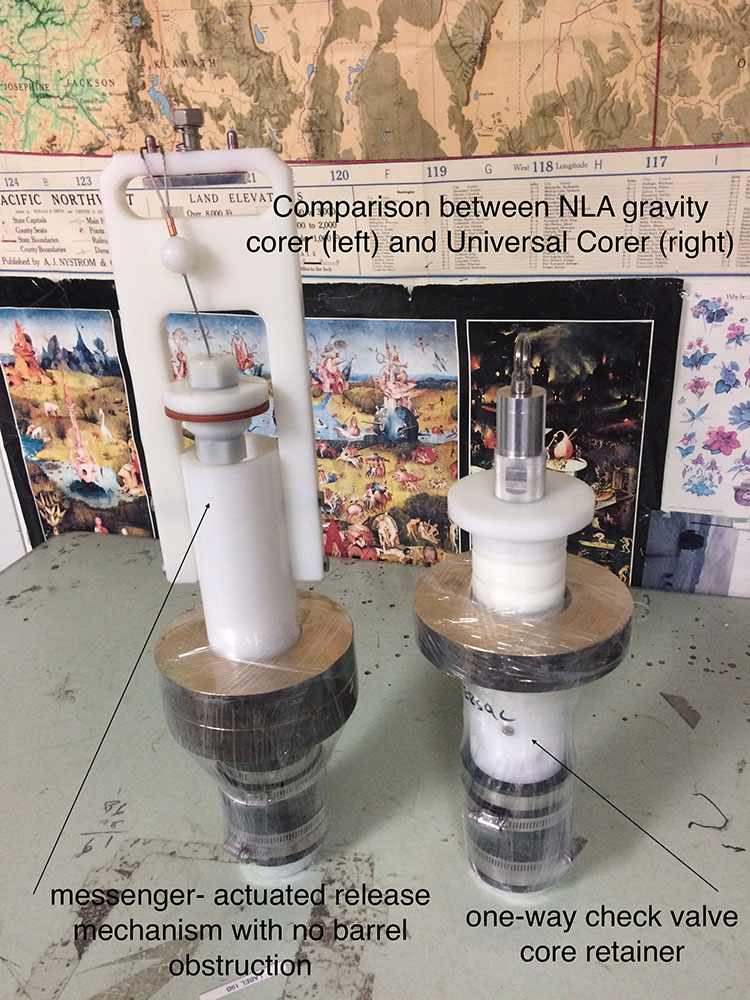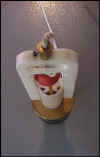 |

Home
AR News
Contact Us
PLANKTON NETS
Simple Plankton Nets
Closing Plankton Nets
Bongo Plankton Nets
Multi-Net (Tucker) Trawl
Student Plankton Nets
Stream Sampling Nets
WATER SAMPLERS
Horizontal Water Samplers
Vertical Water Samplers
Student Water Samplers
Secchi Disks
Limnology Field Kits
SEDIMENT CORERS
Universal Percussion Corer
Gravity Corer
Russian Peat Borer
Piston Interface Corer
Large Bore Sediment Sampler
Pore-Water Sampling
Extension Rods and Percussion
Hammer
Core Extruding Apparatus
Discrete Point Piston Corer
PLANKTON SAMPLERS
Plankton Traps
Haney Grazing Chambers
Light Traps
Limnocorrals, Microcosms, Enclosures
LABORATORY EQUIPMENT
Utermoehl (Phytoplankton) Sedimentation Chambers
Folsom Plankton Sample Splitter
Motoda Plankton Sample Splitter
Zooplankton Counting Trays
QUESTIONS & COMMENTS
REQUEST A QUOTE
PLACE AN ORDER
DELIVERY TIMES
|
 |

Visit AquaticResearchShop.com
Secure Online Shopping for GRAVITY (NLA) CORER
Gravity NLA Corer

 Paleoecological analysis Paleoecological analysis- Deep water sediments
- Benthic community analysis
- Undisturbed collection of mud-water interface
Gravity Corer
Unit Includes:
- core head with release mechanism
- Delrin® and stainless steel construction
- rubberball is held in the open or "free-flushing" position by a release pin during penetration thus preventing
frontal wave disturbance of sediments
- No core cathees required
- bronze messenger
- 300 gm, sollid bronze (split messengers are optional)
- actuates release
of ball (under tension from a latex band) and sealing of core head
- vaccuum seal retaines
sediments in core tube during retrieval
- bronze cavity weights
- bronze holobar construction, 7.5 cmid x 15 cmod x 3 kg each, staked on body of core head, weights are easily removed and added maximum capacity four each.
- polycarbonate core barels
- proven to produce the best quality samples with minimum amount of sample loss, 2 5/8” (68mmid) x 2 3/4” (71mmod) thin walled barrels with chamfered (sharpened) ends, poly end caps, core extruding plugs (optional).
Available in standard lengths of: 60 cm, 1.2 m, and 2.4
GRAVITY CORER
 Polyethylene, polycarbonate and stainless steel construction Polyethylene, polycarbonate and stainless steel construction- rubber ball-type core retainer w/ latex band
- simple-all angle-release mechanism, solid bronze messenger (400 gm)
- 20m x 10mm diam. polyester lowering line, linereel
- 1 each bronze gravity weights (4 kg ea, five ea. max. capacity)
- one-ea. thin-walled-clear polycarbonate core barrel (68 mm x 71 mm x 60 cm)
 core extruding plug core extruding plug- poly end caps
- spares
- heavy duty toolbox carry case
- hexdriver
- 20m low streach polyester line and line reel
- polycarbonate core barels - proven to produce the best quality samples with minimum amount of sample loss, 2 5/8” (68mmid) x 2 3/4” (71mmod) thin walled barrels with chamfered (sharpened) ends, poly end caps, core extruding plugs (optional).
Available in standard lengths of: 60 cm, 1.2 m, and 2.4 m
Notes: Sample disturbance and compression are minimized by the thin-walled, free flushing core barrels. Ball-type seal held in the open position during deployment, which ensures good flushing. Sediments are retained in the core barrel by a vacuum created by an excellent ball seal, not core-catchers.
Upon retrieval, one must plug the bottom of the core tube before breaking the air-water interface (with core extruding plug or poly end cap) to prevent loss of sample. Clear polycarbonate core barrel material readily available at most plastic distributors.
Core extruding plugs allow one to incrementally extrude sediments upward with aid of a Core Extruding Apparatus. Core barrels can easily be drilled/plugged (for pore water extraction), serrated, cut and split to meet the special needs of the investigation.
NLA GRAVITY CORER (National Lakes Assessment Corer)


Coring Tips and Directions:
(BEFORE YOU DEPLOY THE SAMPLER)
A Messenger threaded on the line and nested inside the line reel to prevent damage during shipping.
Inspect the line for any abrasions, especially near the Knot and Release Mechanism w/ Pin. Replace the line and secure the knot with a minimum 5 cm long tail.
Secure the end of the towline to a solid object aboard. This will prevent accidental loss of sampler.
Inspect and secure Retainer Ring to prevent loss of weights during deployment.
Inspect and secure Upper Hose Clamps on Rubber Boot to prevent loss of Gravity Weights and/or Core Barrel during deployment. “NO” is a written reminder that means…DO NOT LOOSEN!
(PREAPRING THE CORER FOR DEPLOYMENT) Loosen the Lower Hose Clamps. “YES” is a written reminder that means…OK to LOOSEN! Slide the Core Barrel onto the head until it stops. Use 5/16” screwdriver (included) to clamp the Rubber Boot to Core Barrel. Be sure to double check that all Hose Clamps (4 each x Upper and Lower) are secured very tightly. If not, you one may loose the barrel or fail to collect a complete sample. A perfect seal (partial vacuum) is required to hold the sample in the Barrel during retrieval. Arm the sampler in the “open” position pulling upwards on the Rubber Ball and hook Lanyard on Release Mechanism Pin. The sampler is ready for deployment.
(DEPLOYING THE CORER) Generally speaking…coring is an art where quality samples are difficult to collect and extrude. Some researchers spend the better part of a career to collect a few “good cores”. Many site variables exist to complicate any coring operation: lake type (natural vs. man –made), substrate type (soft organic gytta to sands), patchy depositional zones, deep lake depths and platform drift… It requires considerable practice to collect good quality cores. Calm sampling conditions and a secure platform are important factors for collecting quality samples. Determine the depth of the mud-water interface. Mark the lowering line with section of tape or wire tie for future reference. Collecting a quality sample is a very gentle operation. Do not “Drop or Free Fall” the sampler. Lower the sampler to the mud-water interface. Then, allow the sampler to slowly core the sediment to the desired depth. Try to re-mark the line at the final sampling depth. This mark may help you determine how to deploy on successive attempts.
Drop the messenger to actuate the ball to seal the core head. You do not have to throw the messenger downward to trip the Release Mechanism.
Try to recover the sampler as quickly as possible without any jerking motion.
Important point during final recovery… before the end of the Core Barrel breaks the air-water interface, you must plug the bottom of the barrel with either a Core Extruding Plug or Poly End Cap. Otherwise, you will lose the whole (or part) of the sample. With the plug in place, it is now safe to lift the corer on board. Before transporting, double cap Core Barrel with orange Poly End Caps. With the Core Extruding Plug in place, the sample is prepared for the extruding process.
If you overdrive the sampler into the mud, the rubber ball may become fouled with not hold a seal. Try to deploy the sampler again at a shallower depth.
(TROUBLE SHOOTING) If you fail to collect a sample the first thing to do is check the seal of the Rubber ball. Completely immerse the sampler in shallow water and actuate the sampler to closed position.
Next, lift the sampler into the air without the end of the Core Barrel breaking the air-water interface. The core barrel should hold the water column intact without leaking.
If the corer is not holding the full column, you may have a leak in the Rubber Ball seal. The Latex tubing pulling downward on the ball can be easily adjusted. Remove the Lanyard Loop and pull the latex tubing though the ball to expose the “stopper”. Next, use a screwdriver to push the “stopper” inwards, thus to shorten the length of the latex tubing and increase tension on the Rubber Ball.. Re-install the Lanyard and test the seal again.
Citations:
Blomqvist, S., 1991. Quantitative sampling of soft bottom sediments: problems and solutions. Mar. Ecol. Prog. Ser., 72:295-304. Aaby, B., Digerfeldt, G. 1986. Sampling techniques for lakes and bogs. In: Berglund, B.E. (ed.) Handbook of Holocen Paleoecology and Paleohydrology. John Wiley & Sons, Chichester, pp. 181-194. Downing, J.A. 1984. Sampling the benthos in standing waters. In: Downing, J.A., Rigler, F.H. (eds) A Manual on Methods for the Assesment of Secondary Production in Fresh Waters, 2nd edn. IBP handbook No.17. Blackwell Scientific Publications, Oxford, pp. 87-130.
Visit AquaticResearchShop.com
Secure Online Shopping for GRAVITY (NLA) CORER
|
 |


